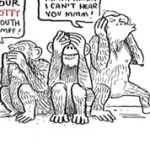Once as a brand manager I was shown the same storyboard twice, a couple of years apart. The twist? This “new ad concept” was presented for two entirely different product categories at two different companies. Detergent and food. Same agency. (BBDO, if you must know.) I don’t recall the storyboard, but I’m certain it was the same generic, gratuitous entertainment I’d come to expect. Nary a distinctive brand truth in sight.
Ditto for Sunday’s Super Bowl ads. The game was exciting and wasn’t Beyoncé terrific? But the ads were almost entirely stale, even when outfitted with new effects and cultural references, because they fit into predictable categories. There were a (very) few notable exceptions, and only one stunner. I’ll cover these in my next post.
May I present the Three Categories of Super Bowl ads?
1. AnyBrand Entertainment
Like the aforementioned storyboard, these are stand-alone bits that could be tweaked to work for nearly any brand, in nearly any category of product. A few have requirements like an irresistibility story (Doritos) or Big American Brand (Jeep, Ram Truck), but any number of brands could sub in for the brand featured in these ads.
The biggest category by far, AnyBrand Entertainment came in assorted flavors:
- Comedy: Toyota RAV4 (“Wish Granted”), Kia (“Space Babies”), Doritos (“Goat 4 Sale” and “Daddy Fashionista”), and Oreo (“Whisper Fight”), Gildan (“Getaway”).
- Celebrity Comedy: Samsung (Paul Rudd and Seth Rogan) and Best Buy (Amy Poehler)
- Drama: Jeep (“Whole Again”) and Ram Truck (“Farmer”)
- Action: Blackberry (“What Blackberry 10 Can’t Do”)
- Music/Dance: Pistachios (“Gangnam Style”)
Of course, some of these are fun to watch. But it’s such a waste, especially when you think of the outlandish production and media expenses. Not a single one of these ads is likely to have lasting impact on the brand, no matter how entertaining or heartwarming, because the brand funding it all isn’t intrinsic to the show. The show’s the thing.
2. Screeching Stereotypes
This category serves up clichés for yucks. No need to think, when you can just put a new band on an old hat and recharge those old biases to boot!
- Race: VW (“Get Happy”). Gotta love those happy island natives!
- Sex: Go Daddy (anything) and Speed Stick (“Laundry”). Hubba hubba!
- Age: Taco Bell (“Viva Young”). Ain’t them geezers something?
- Mothers-in-law: Century 21 (“Wedding”). Harpy begone!
The only conceivable value from these bottom-fishers is reminding people of the brand name. Yet who would honestly want to be associated with such tired and offensive conventionality?
3. What Did You Expect?
This category could also be called There You Go Again. Another incarnation of the same shtick, this time at stratospheric prices for Super Bowl airtime and, in some cases, the celebrities you’ve added. We know you, and may even enjoy your ads (what’s the E-Trade talking baby going to say this time?), but you’re not exactly breaking new ground here.
Examples include: GoDaddy, Pepsi, Calvin Klein, E-Trade, and Bud Light.
This category may have signal value, like having a store on Fifth Avenue. It says: “We’re still here and have money to burn.” So it’s the most sensible investment of the three categories. And hey, it was fun to see Stevie Wonder. But still, at nearly $4 million for 30 seconds, is it too much to ask for something a little grander than More of the Same?
Next up: The proud, the few. Notable ads from Super Bowl 2013.







